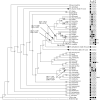The Cape element in the Afrotemperate flora: from Cape to Cairo?
- PMID: 17476774
- PMCID: PMC1766381
- DOI: 10.1098/rspb.2006.0046
The Cape element in the Afrotemperate flora: from Cape to Cairo?
Abstract
The build-up of biodiversity is the result of immigration and in situ speciation. We investigate these two processes for four lineages (Disa, Irideae p.p., the Pentaschistis clade and Restionaceae) that are widespread in the Afrotemperate flora. These four lineages may be representative of the numerous clades which are species rich in the Cape and also occur in the highlands of tropical Africa. It is as yet unclear in which direction the lineages spread. Three hypotheses have been proposed: (i) a tropical origin with a southward migration towards the Cape, (ii) a Cape origin with a northward migration into tropical Africa, and (iii) vicariance. None of these hypotheses has been thoroughly tested. We reconstruct the historical biogeography of the four lineages using likelihood optimization onto molecular phylogenies. We find that tropical taxa are nested within a predominantly Cape clade. There is unidirectional migration from the Cape into the Drakensberg and from there northwards into tropical Africa. The amount of in situ diversification differs between areas and clades. Dating estimates show that the migration into tropical East Africa has occurred in the last 17 Myr, consistent with the Mio-Pliocene formation of the mountains in this area.
Figures



Similar articles
-
Contrasting patterns of radiation in African and Australian Restionaceae.Evolution. 2003 Dec;57(12):2688-702. doi: 10.1111/j.0014-3820.2003.tb01513.x. Evolution. 2003. PMID: 14761050
-
Frequent and parallel habitat transitions as driver of unbounded radiations in the Cape flora.Evolution. 2017 Nov;71(11):2548-2561. doi: 10.1111/evo.13364. Epub 2017 Oct 17. Evolution. 2017. PMID: 28884804
-
Evolution of the species-rich Cape flora.Philos Trans R Soc Lond B Biol Sci. 2004 Oct 29;359(1450):1623-32. doi: 10.1098/rstb.2004.1534. Philos Trans R Soc Lond B Biol Sci. 2004. PMID: 15519977 Free PMC article.
-
Explaining the uniqueness of the Cape flora: incorporating geomorphic evolution as a factor for explaining its diversification.Mol Phylogenet Evol. 2009 Apr;51(1):64-74. doi: 10.1016/j.ympev.2008.05.034. Epub 2008 Jun 4. Mol Phylogenet Evol. 2009. PMID: 18691908 Review.
-
Biogeography and speciation of terrestrial fauna in the south-western Australian biodiversity hotspot.Biol Rev Camb Philos Soc. 2015 Aug;90(3):762-93. doi: 10.1111/brv.12132. Epub 2014 Aug 15. Biol Rev Camb Philos Soc. 2015. PMID: 25125282 Review.
Cited by
-
Let's get high: Cladogenesis in freshwater crabs (Decapoda: Potamonautidae: Potamonautes) supports the mountain gradient speciation hypothesis in the Cape Fold and Drakensberg Mountains, South Africa.Ecol Evol. 2024 Mar 5;14(3):e10960. doi: 10.1002/ece3.10960. eCollection 2024 Mar. Ecol Evol. 2024. PMID: 38450318 Free PMC article.
-
Tectonics, climate and the diversification of the tropical African terrestrial flora and fauna.Biol Rev Camb Philos Soc. 2021 Feb;96(1):16-51. doi: 10.1111/brv.12644. Epub 2020 Sep 13. Biol Rev Camb Philos Soc. 2021. PMID: 32924323 Free PMC article.
-
African Mountain Thistles: Three New Genera in the Carduus-Cirsium Group.Plants (Basel). 2023 Aug 28;12(17):3083. doi: 10.3390/plants12173083. Plants (Basel). 2023. PMID: 37687332 Free PMC article.
-
The scramble for Africa: pan-temperate elements on the African high mountains.Proc Biol Sci. 2009 Jul 22;276(1667):2657-65. doi: 10.1098/rspb.2009.0334. Epub 2009 Apr 29. Proc Biol Sci. 2009. PMID: 19403534 Free PMC article.
-
Four new bat species (Rhinolophus hildebrandtii complex) reflect Plio-Pleistocene divergence of dwarfs and giants across an Afromontane archipelago.PLoS One. 2012;7(9):e41744. doi: 10.1371/journal.pone.0041744. Epub 2012 Sep 12. PLoS One. 2012. PMID: 22984399 Free PMC article.
References
-
- Adamson R.S. The Cape as an ancient African flora. Adv. Sci. 1958;58:1–10.
-
- Axelrod D.I, Raven P.H. Late Cretaceous and Tertiary vegetation history of Africa. In: Werger M.J.A, editor. Biogeography and ecology of southern Africa. Dr. W. Junk bv Publishers; The Hague, The Netherlands: 1978. pp. 77–130.
-
- Bonnefille R, Potts R, Chalié F, Jolly F, Peyron D. High-resolution vegetation and climate change associated with Pliocene Australopithecus afarensis. Proc. Natl Acad. Sci. USA. 2004;101:12 125–12 129. doi:10.1073/pnas.0401709101 - DOI - PMC - PubMed
-
- Born J, Linder H.P, Desmet P. The Greater Cape Floristic Region. J. Biogeogr. 2006 doi:10.1111/j.1365-2699.2006.01595.x - DOI
-
- Bytebier B, Bellstedt D.U, Linder H.P. A molecular phylogeny for the large African orchid genus Disa. Mol. Phylogenet. Evol. 2006 doi:10.1016/j.ympev.2006.04.014 - DOI - PubMed
Publication types
MeSH terms
LinkOut - more resources
Full Text Sources

